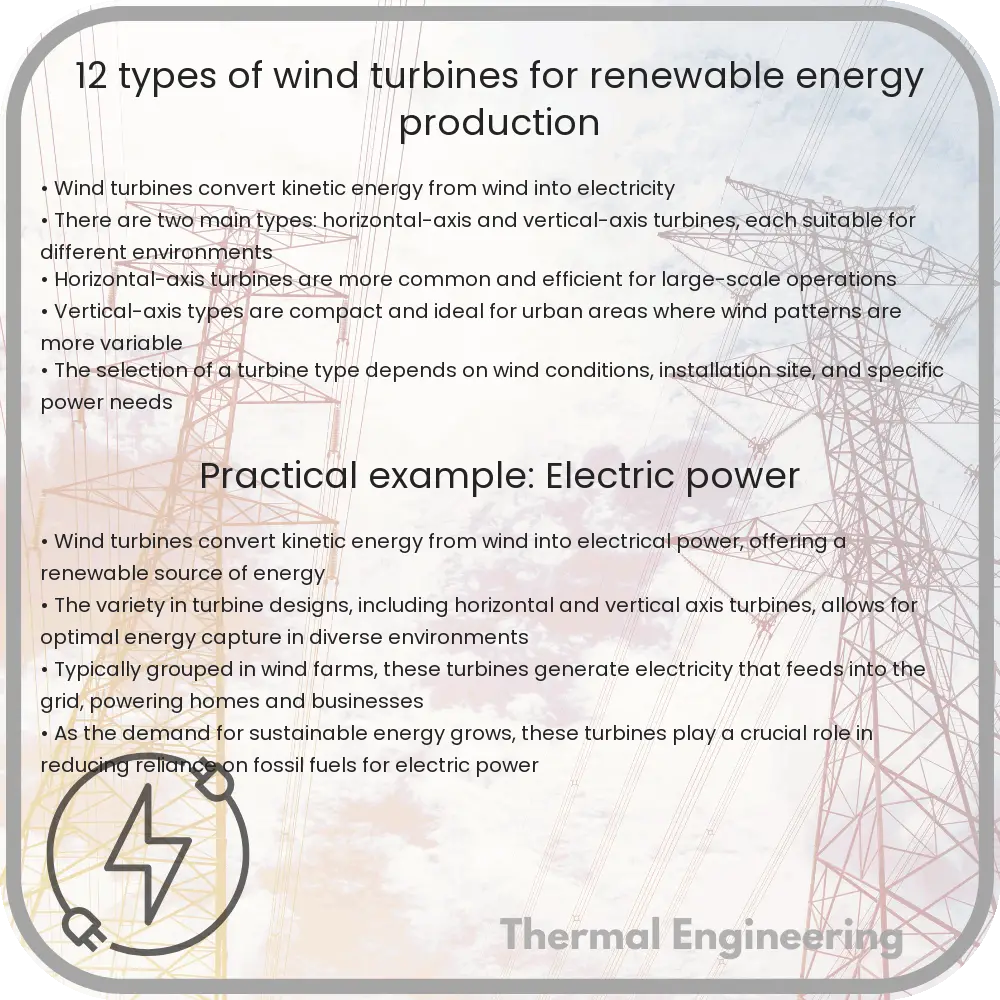Explore 12 common types of wind turbines used in renewable energy production, detailing their unique designs and applications.

12 Types of Wind Turbines for Renewable Energy Production
Wind turbines are a cornerstone of renewable energy production, harnessing the natural power of the wind to generate electricity. There are several types of wind turbines, each with unique characteristics and suitable for different environments. Below, we explore 12 common types of wind turbines used in the field of renewable energy.
1. Horizontal-Axis Wind Turbines (HAWTs)
The most common type of wind turbine is the Horizontal-Axis Wind Turbine (HAWT). These turbines have a main rotor shaft and electrical generator at the top of a tower, and must be pointed into the wind. They typically have two or three blades and operate efficiently in high-wind conditions.
2. Vertical-Axis Wind Turbines (VAWTs)
Vertical-Axis Wind Turbines (VAWTs) have a vertically oriented rotor shaft. The two primary designs in this category are the Savonius and Darrieus models, which differ in blade design and rotational dynamics. VAWTs are advantageous in that they can capture wind from any direction.
3. Darrieus Wind Turbines
Named after its inventor Georges Darrieus, these turbines have a rotor with a shape akin to an egg beater. Darrieus turbines are a type of VAWT that is efficient but may require an external power source for starting.
4. Savonius Wind Turbines
Another type of VAWT, Savonius turbines feature rotor blades that are essentially scooped drums. These turbines prioritize torque over speed, making them useful in applications where high-starting torque is required.
5. Giromill Turbines
A subtype of Darrieus turbine, Giromill features straight, as opposed to curved, blades. These are simpler to construct and can operate in a narrower range of wind speeds.
6. Cycloturbines
Cycloturbines, also a variant of the Darrieus type, have adjustable blade pitch, which helps control rotational speed and maximize efficiency across varying wind conditions.
7. Hybrid Darrieus-Savonius Turbines
This design combines elements of both Darrieus and Savonius turbines to improve efficiency and torque. The Savonius components help start the turbine, and the Darrieus blades provide efficient energy conversion.
8. Offshore Wind Turbines
Offshore wind turbines are HAWTs specifically designed for installation in large bodies of water, where wind speeds are typically higher. These turbines can be much larger and generate more power.
9. Onshore Wind Turbines
Conventional onshore wind turbines are predominantly HAWTs. These turbines are installed in rural or remote land areas and are among the most visible forms of renewable energy infrastructure.
10. Ducted Rotor Turbines
These turbines feature a duct or shroud that helps to channel and accelerate wind onto the blades, increasing the turbine’s power output. This setup is particularly effective in lower wind speed areas.
11. Tethered Airborne Turbines
Tethered airborne turbines float high in the atmosphere, capturing energy from wind currents that are stronger and more consistent than those reached by traditional ground-based turbines. These systems are still largely in the experimental phase.
12. Portable Wind Turbines
As the name suggests, portable wind turbines are designed for easy transport and installation, making them ideal for temporary setups, rural areas, or emergency power needs. These types often utilize VAWT designs for their omnidirectional wind capture capabilities.
As the quest for cleaner and more sustainable energy sources continues, the technology behind wind turbines is constantly evolving, with new designs and innovations emerging regularly. Each type of wind turbine offers specific advantages, making them suitable for different applications and environments in the global effort to harness renewable energy.